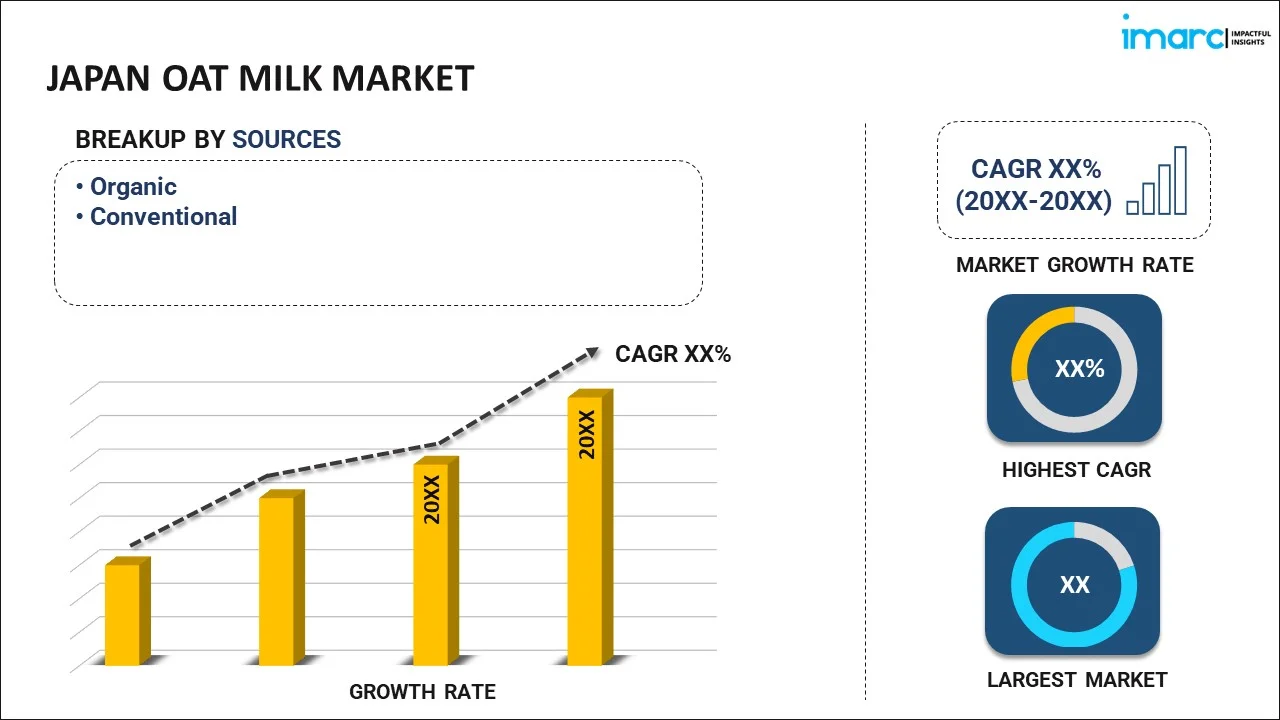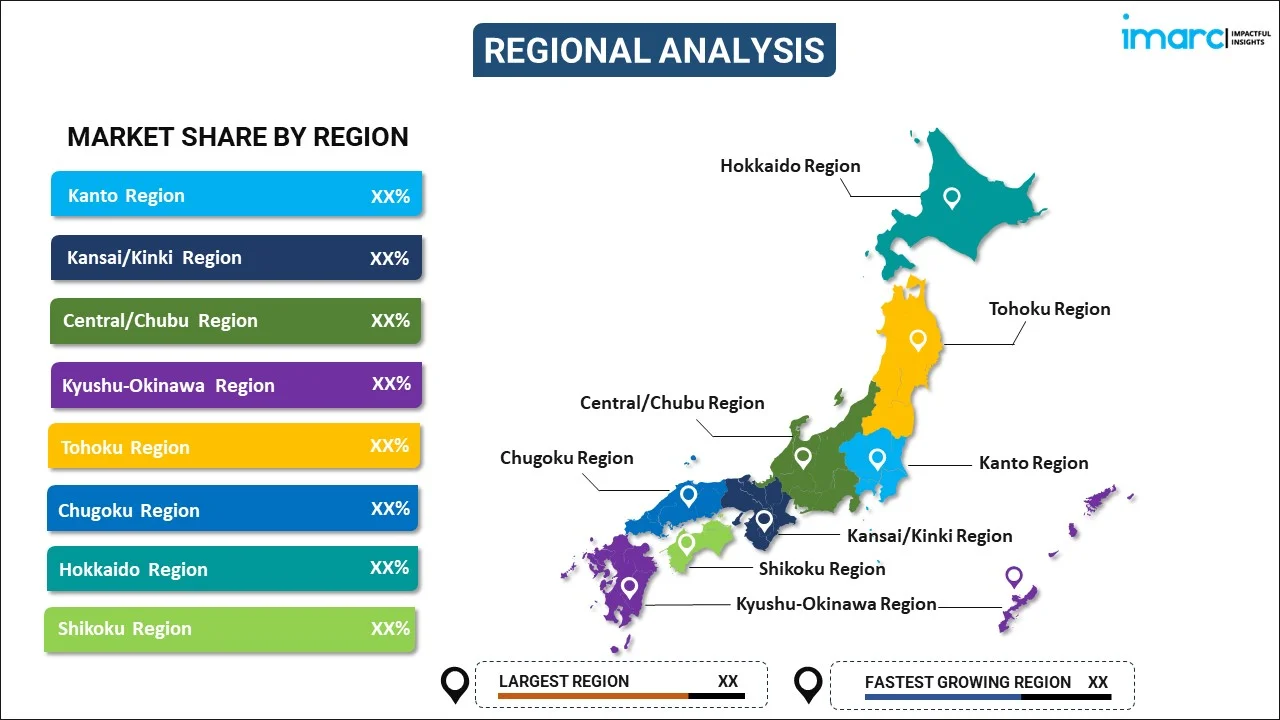
Japan Oat Milk Market Report by Source (Organic, Conventional), Product (Plain, Flavored), Packaging Type (Cartons, Bottles, and Others), Application (Food, Beverages), Distribution Channel (Supermarkets and Hypermarkets, Grocery Stores, Online Stores, and Others), and Region 2025-2033
Market Overview:
Japan oat milk market size reached USD 51.7 Million in 2024. Looking forward, IMARC Group expects the market to reach USD 163.1 Million by 2033, exhibiting a growth rate (CAGR) of 12.6% during 2025-2033. The increasing popularity of plant-based diets and lifestyles, including veganism and vegetarianism, which has boosted the demand for plant-based milk alternatives like oat milk, is driving the market.
|
Report Attribute
|
Key Statistics
|
|---|---|
|
Base Year
|
2024
|
|
Forecast Years
|
2025-2033
|
|
Historical Years
|
2019-2024
|
|
Market Size in 2024
|
USD 51.7 Million |
|
Market Forecast in 2033
|
USD 163.1 Million |
| Market Growth Rate 2025-2033 | 12.6% |
Oat milk is a dairy-free, plant-based milk alternative made from whole oat grains. To create oat milk, oats are soaked in water, blended, and then strained to remove solids, resulting in a creamy liquid with a mild, slightly sweet flavor. Oat milk has gained popularity in recent years as a versatile and nutritious substitute for cow's milk. One of the key benefits of oat milk is its nutritional profile. It is often fortified with vitamins and minerals, such as calcium and vitamin D, making it a suitable replacement for traditional milk in terms of nutrient content. Additionally, oat milk is naturally free of cholesterol and saturated fats, which can be advantageous for heart health. Oat milk has a neutral taste, making it suitable for a wide range of culinary applications, from coffee and tea to cereal, baking, and cooking. It is known for its creamy consistency, which can be particularly appealing in lattes and other coffee beverages. Oat milk's popularity is also driven by its eco-friendliness, as it typically has a lower environmental impact compared to dairy milk production.
Japan Oat Milk Market Trends:
The oat milk market in Japan is experiencing rapid growth, primarily driven by shifting consumer preferences and increasing awareness of health and sustainability concerns. Firstly, consumer demand for dairy alternatives has surged, with many individuals seeking healthier options. Consequently, oat milk, known for its low saturated fat content and absence of cholesterol, has gained prominence as a preferred dairy substitute. Moreover, the rise of lactose intolerance and dairy allergies has further boosted oat milk's popularity, as it offers a lactose-free and allergen-friendly alternative. Furthermore, the growing awareness of environmental issues and animal welfare has led to an increased interest in plant-based products, including oat milk. Oats are considered a sustainable crop due to their relatively low environmental impact compared to traditional dairy farming. This aligns with the preferences of eco-conscious consumers who prioritize products with a smaller carbon footprint. Additionally, the ongoing innovation and product development to launch new oat milk items, including flavored varieties, barista blends, and organic options that help maintain consumer interest, is expected to drive the market in Japan during the forecast period.
Japan Oat Milk Market Segmentation:
IMARC Group provides an analysis of the key trends in each segment of the market, along with forecasts at the country level for 2025-2033. Our report has categorized the market based on source, product, packaging type, application, and distribution channel.
Source Insights:

- Organic
- Conventional
The report has provided a detailed breakup and analysis of the market based on the source. This includes organic and conventional.
Product Insights:
- Plain
- Flavored
A detailed breakup and analysis of the market based on the product have also been provided in the report. This includes plain and flavored.
Packaging Type Insights:
- Cartons
- Bottles
- Others
The report has provided a detailed breakup and analysis of the market based on the packaging type. This includes cartons, bottles, and others.
Application Insights:
- Food
- Beverages
A detailed breakup and analysis of the market based on the application have also been provided in the report. This includes food and beverages.
Distribution Channel Insights:
- Supermarkets and Hypermarkets
- Grocery Stores
- Online Stores
- Others
The report has provided a detailed breakup and analysis of the market based on the distribution channel. This includes supermarkets and hypermarkets, grocery stores, online stores, and others.
Regional Insights:

- Kanto Region
- Kansai/Kinki Region
- Central/ Chubu Region
- Kyushu-Okinawa Region
- Tohoku Region
- Chugoku Region
- Hokkaido Region
- Shikoku Region
The report has also provided a comprehensive analysis of all the major regional markets, which include Kanto Region, Kansai/Kinki Region, Central/ Chubu Region, Kyushu-Okinawa Region, Tohoku Region, Chugoku Region, Hokkaido Region, and Shikoku Region.
Competitive Landscape:
The market research report has also provided a comprehensive analysis of the competitive landscape in the market. Competitive analysis such as market structure, key player positioning, top winning strategies, competitive dashboard, and company evaluation quadrant has been covered in the report. Also, detailed profiles of all major companies have been provided.
Japan Oat Milk Market Report Coverage:
| Report Features | Details |
|---|---|
| Base Year of the Analysis | 2024 |
| Historical Period | 2019-2024 |
| Forecast Period | 2025-2033 |
| Units | Million USD |
| Scope of the Report | Exploration of Historical Trends and Market Outlook, Industry Catalysts and Challenges, Segment-Wise Historical and Future Market Assessment:
|
| Sources Covered | Organic, Conventional |
| Products Covered | Plain, Flavored |
| Packaging Types Covered | Cartons, Bottles, Others |
| Applications Covered | Food, Beverages |
| Distribution Channels Covered | Supermarkets and Hypermarkets, Grocery Stores, Online Stores, Others |
| Regions Covered | Kanto Region, Kansai/Kinki Region, Central/ Chubu Region, Kyushu-Okinawa Region, Tohoku Region, Chugoku Region, Hokkaido Region, Shikoku Region |
| Customization Scope | 10% Free Customization |
| Post-Sale Analyst Support | 10-12 Weeks |
| Delivery Format | PDF and Excel through Email (We can also provide the editable version of the report in PPT/Word format on special request) |
Key Questions Answered in This Report:
- How has the Japan oat milk market performed so far and how will it perform in the coming years?
- What has been the impact of COVID-19 on the Japan oat milk market?
- What is the breakup of the Japan oat milk market on the basis of source?
- What is the breakup of the Japan oat milk market on the basis of product?
- What is the breakup of the Japan oat milk market on the basis of packaging type?
- What is the breakup of the Japan oat milk market on the basis of application?
- What is the breakup of the Japan oat milk market on the basis of distribution channel?
- What are the various stages in the value chain of the Japan oat milk market?
- What are the key driving factors and challenges in the Japan oat milk?
- What is the structure of the Japan oat milk market and who are the key players?
- What is the degree of competition in the Japan oat milk market?
Key Benefits for Stakeholders:
- IMARC’s industry report offers a comprehensive quantitative analysis of various market segments, historical and current market trends, market forecasts, and dynamics of the Japan oat milk market from 2019-2033.
- The research report provides the latest information on the market drivers, challenges, and opportunities in the Japan oat milk market.
- Porter's five forces analysis assist stakeholders in assessing the impact of new entrants, competitive rivalry, supplier power, buyer power, and the threat of substitution. It helps stakeholders to analyze the level of competition within the Japan oat milk industry and its attractiveness.
- Competitive landscape allows stakeholders to understand their competitive environment and provides an insight into the current positions of key players in the market.
Need more help?
- Speak to our experienced analysts for insights on the current market scenarios.
- Include additional segments and countries to customize the report as per your requirement.
- Gain an unparalleled competitive advantage in your domain by understanding how to utilize the report and positively impacting your operations and revenue.
- For further assistance, please connect with our analysts.
 Request Customization
Request Customization
 Speak to an Analyst
Speak to an Analyst
 Request Brochure
Request Brochure
 Inquire Before Buying
Inquire Before Buying




.webp)




.webp)












